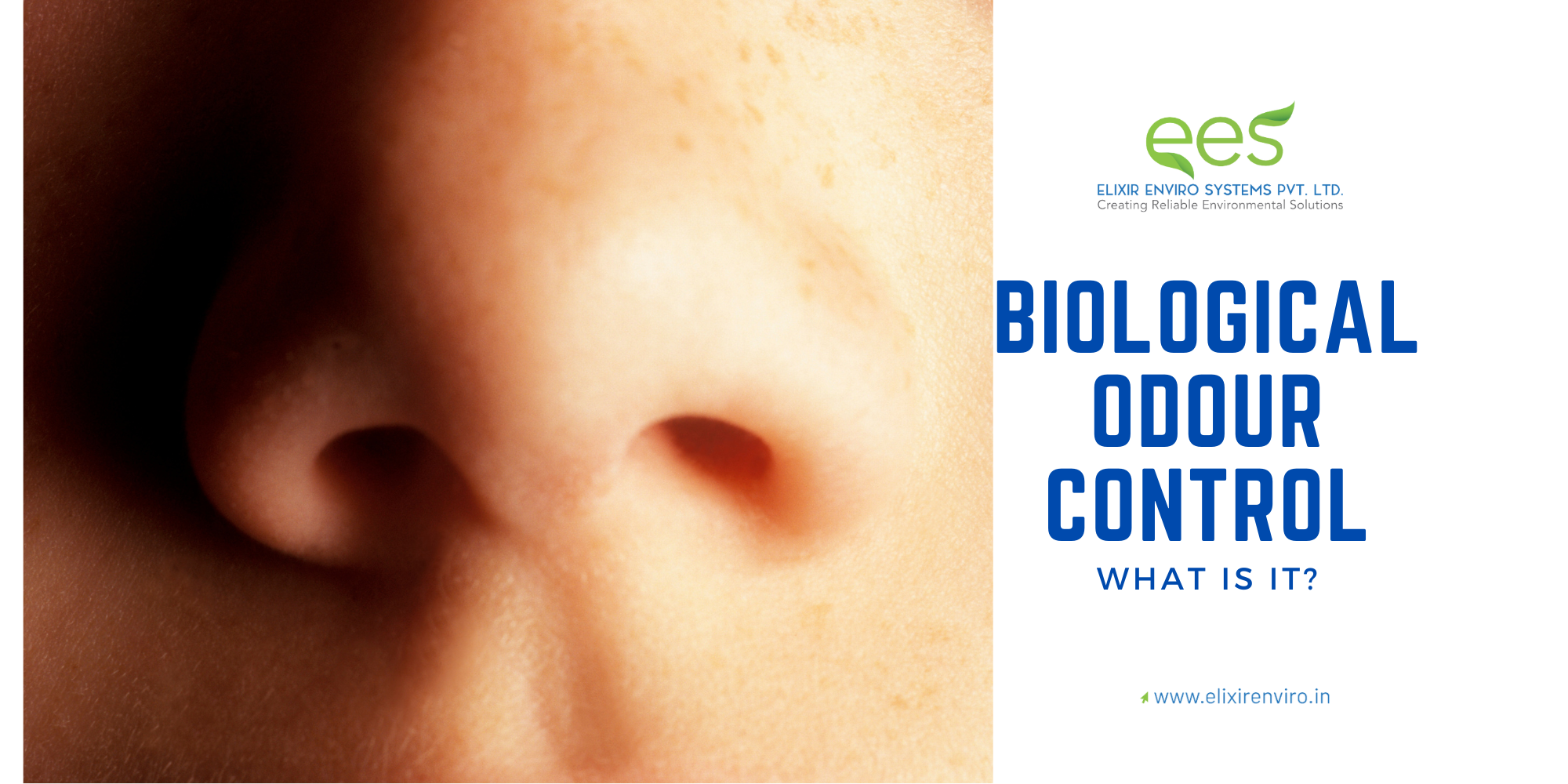
Introduction
Last March, residents of Sector 28 Vashi, Navi Mumbai complained of a toxic smell from the local industrial area. The people said that the chemical manufacturers in the neighbouring Trans Thane Creek (TTC) industrial region are the source of the toxic smell. They complained that the toxic smell caused severe discomfort affecting their health and caused contamination of water (Free Press Journal- 8th March 2024)
For many years, residents of Ivy City, Northeast Washington complained of a burning stench in this area. It is only recently that they were able to find the reason behind this. Environmentalists, community activists and residents have concluded that the stench is mainly because of a manufacturing facility- National Engineering Products(NEP) Inc. that makes a sealant for the Navy, using chemicals such as formaldehyde, acetonitrile and methylene chloride. Community activists and environment activists, along with neighbours, worry that NEP’s emissions could endanger nearby families(The Washington Post- 11th April 2024).
The problems caused by Industrial odours are not just limited to India but affect the whole world. Industrial odours arise as a result of industrial processes that release different compounds as byproducts. In low concentrations, these compounds may cause discomfort, nausea, sleeplessness and physiological disturbances but at high concentrations, they can cause severe problems including respiratory diseases, increased stress and altered blood flow in the lungs. Thus, the source of these problems must be identified and steps taken to mitigate its release to the atmosphere. This improves health and ensures the overall well-being of the people.
It is observed that industrial odours mainly arise from industries and factories because of the compounds that are released into the environment. Industrial odour is mainly controlled by physical, chemical and biological methods of which the biological method is most significant, mainly due to the sustainability, low cost and feasibility of conducting at moderate temperatures and pressures. The most prominent Biological methods for odour control include use of biofilters, bioscrubbers and biotrickling filters.
Odour Generating Industries
Industrial odour are generated by variety of organisations, industries and facilities. It includes
In Ireland in 2023, 90% of the complaints made to EPA (Environmental Protection Agency) were due to noise and odour from various industries like food, recycling, creameries and waste disposal. The Kerala State Pollution Control Board (KSPCB) commissioned a study on the odour pollution-related issues at Edayar Industrial Area in September 2022. The study was done by the CSIR-National Institute for Interdisciplinary Science and Technology (NIIST), Trivandrum on behalf of KSPCB. The study found several deficiencies in the operation of odour control units installed in nearly 20 bonemeal units, chicken waste rendering plans and rubber processing units in the Edayar industrial area.
Causes
Odour from industrial establishments is caused by the chemicals present in the exhaust gas. There are many chemicals responsible for the odorous compounds. Hydrogen sulphide, Sulphur dioxide/ trioxide, nitrogen oxides, ozone, ammonia, volatile fatty acids (eg butyric acid), aldehydes and ketones (eg formaldehyde), mercaptans, amines and alcohols contribute majorly to the odour generated. These chemicals are majorly generated by various industries.
Hydrogen sulphide is a gas with a rotten egg smell. It is detectable at very low concentrations. It is colourless and found in many cleaning products, and animal waste and is a byproduct of several industrial processes like oil refining, mining, craft paper production, rayon manufacturing, food processing, wood pulp processing and tanning. People living near these kinds of industries are most exposed to hydrogen sulphide.
Ammonia and ammonium compounds are also major contributors to Industrial odour. It mainly arises from large-scale animal feed manufacturing, municipal waste treatment plants operations (generally as the byproduct of protein degradation), production of fertilizers, pharmaceutical production and food processing operations. Known for its pungent and piercing smell, ammonia (NH3) is frequently present in animal faeces and a variety of cleaning products.
Nitrogen oxides are mixture of gases composed of oxygen and nitrogen. The most significant of them include nitric oxide, nitrogen dioxide, nitrogen monoxide and nitrogen pentoxide. Oxides are nitrogen are mostly used in the manufacture of fertilizers, explosives, mining and from wastewater treatment plants. Facilities that use welding materials produce nitric acid or certain explosives and workers employed in such facilities inhale oxides of nitrogen.
Sulphur dioxide is colourless with a sharp and pungent odour and is produced by industrial processes like fertilizer manufacturing, steel making, aluminium smelting, ceramic manufacturing and combustion of fossil fuels.
VOC (volatile organic compounds) are another major source of odour and air pollution. The major contributors are the petrochemical industries, paint manufacturing, pharmaceutical and bulk drug manufacturing industries, chemical industries, rubber processing industries etc. A sub-category under the VOCs are the Volatile Fatty Acids (VFA) like butyric acid, acetic acid and propionic acid also contribute to industrial odours. Such acids are mainly generated during fermentation processes, dairy products as well as in the decomposition of fats and oils. One source of VFAs are through anaerobic degradation of organic materials.
Effects
The effects of hydrogen sulphide depend on the concentration as concentrations higher than 150 ppm can paralyse the olfactory nerve and higher than 200 ppm can be life-threatening. People with asthma may be sensitive even to its low concentrations. High H2S concentrations can induce nausea, headaches, and dizziness through inhalation. Even greater exposure levels have the potential to cause unconsciousness, coma, or respiratory arrest. There have been fatal exposures lasting 30 minutes at doses higher than 600 ppm. Severe exposures that do not cause death could result in long-term consequences such as damage to nerve tissue, paralysis of the facial muscles, or memory loss.
Sulphur dioxide has been linked to cardiovascular diseases and may cause respiratory problems like bronchitis, wheezing, phlegm and asthma attacks. Chromosome abnormalities and sister chromatid exchanges were noted in lymphocytes from workers exposed to 15.92 ppm sulfur dioxide at a fertilizer company in India. Aldehydes and ketones can irritate the eyes, nose, and throat. They can also occasionally have harmful effects on the nervous system.
Ammonia inhalation can lead to respiratory issues, skin and eye irritation, and in extreme situations, lung damage. Oxides of nitrogen can irritate eyes, nose throat and lungs at low levels. Higher exposure can result in the buildup of fluid in the lungs. Inhaling high levels of nitrogen oxides can lead to spasms, swelling of tissues in the throat, burning and even death.
Exposure to the VOCs can cause a ripple effect in the health of human being, Starting from eye, throat and nose irritation to headache and loss of coordination that may extend to damage of liver, kidneys and even the central nervous system. Some of the VOC compounds are known for its carcinogenic properties. Skin and mucous membrane discomfort may result from exposure to volatile fatty acids. These acids have the potential to negatively impact both aquatic and terrestrial creatures by contributing to air and water pollution.
Managing Industrial Odours
Industrial odours is a major cause of complaint and discomfort for people. Owing to its importance in the current age and time, proper management of odour and air emissions from any industry is of utmost importance.. Industrial odours and emissions can be controlled by either physical, chemical or biological means. Physical methods include containment methods such as odour covers, dilution methods like stacks, and site planning.
There are several chemical methods to control industrial odour. Over time many chemical formulas have been developed to treat those compounds generated by industrial processes. The chemical odour control methods include additives “claiming to neutralize the odour”, masking agent (sprays), adsorbents, ozone(ozonation), ultraviolet treatment and catalytic oxidation.
Compared to physical or chemical means, biological order control methods rely solely on bacteria and other microorganisms. These techniques include use of biofilters, bioscrubbers, biotrickling filters, and other bioreactor types. Use of these methods have been reported to be more environmentally friendly and less expensive than physical or chemical methods. It can also be conducted at normal temperatures and is simple to operate. The process is also ecologically clean as the end products are ecologically safe and oxidative in nature. Researches have shown that biological treatment methods can be considered as robust and reliable alternatives to physical or chemical treatment methods.
Biofilters
These are one of the oldest biotechnological odour pollution control techniques used to remove undesired compounds from air. They immobilise microorganisms on a solid support. Biofilters or generally used for removing hydrogen sulphide, VOCs, nitrous oxide, sulphur gases, etc. Use of biofilters can be traced back to 1920s when they were used to remove compounds emitted from animal farms and waste treatment plants. Countries like Germany and Netherlands have used this technology since the 1970s and it became popular in Western Europe and the United States in the 1980s. Europe and Japan have reported the most success in this technology.
Biofilters may be open biofilters or closed biofilters. In open biofilters, the upper part of the bioreactors is open making it more exposed to climate change whereas in closed biofilters parameters such as temperature, fluid composition and fluid flow are easier to monitor and control. The biofilters can also be classified into upflow and downflow biofilters based on the airflow through the media – if the airflow is going from top to bottom of the media, its called downflow biofilter whereas the opposite is called the upflow biofilter. The later is the common practice due to cost constraints mainly.
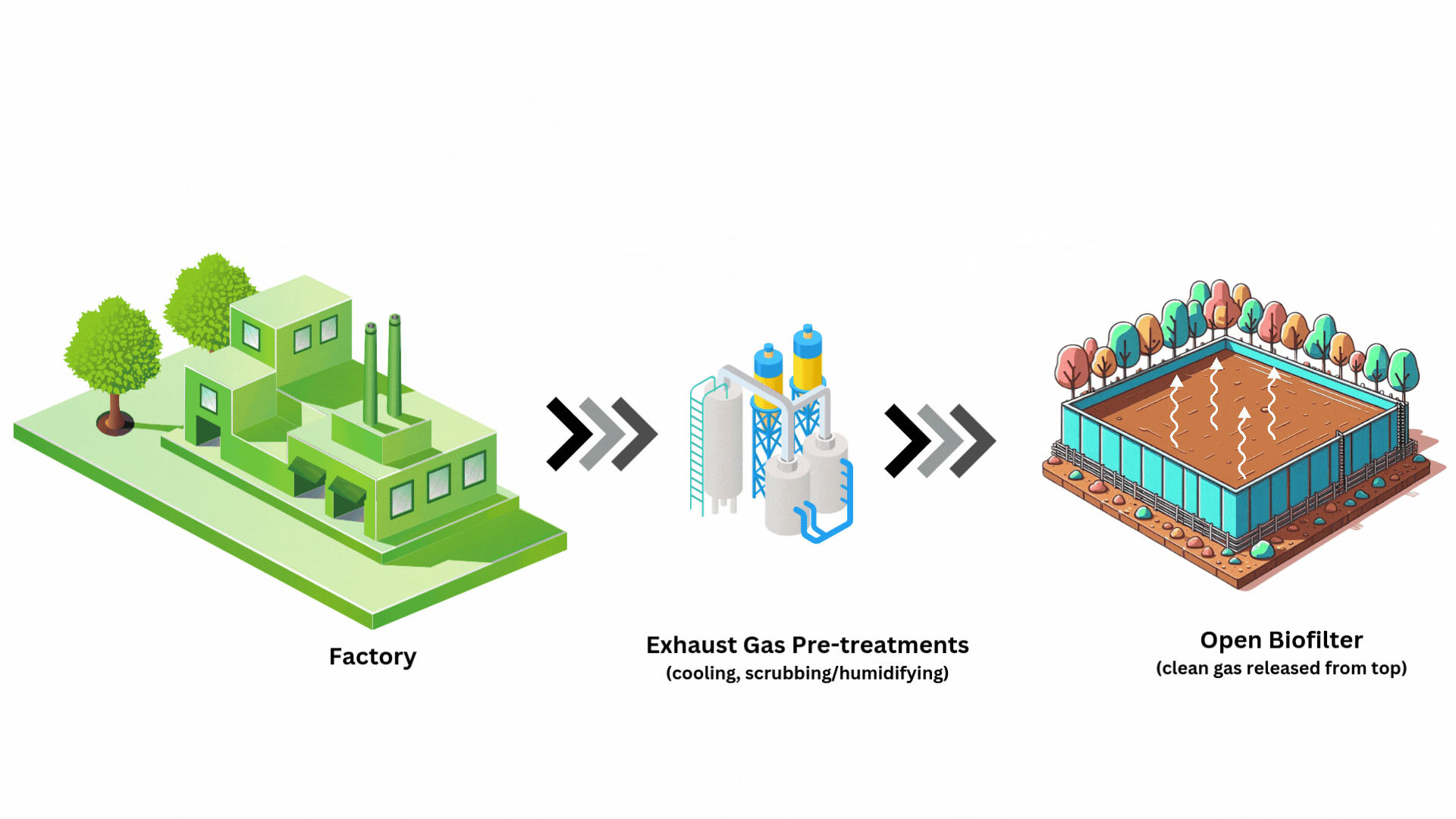
General Arrangement of a Biofilter System
The processes happening in the Biofilter are as follows: Initially, the pollutants are transferred from gas to liquid phase and then subjected to biodegradation by the biofilm. Bacteria constitute chunk of the microorganisms found in the biofilm. Among the bacteria, coryneforms, endospore formers (eg bacilli), pseudomonads and streptomyces are mainly used. The use of bacteria as the best candidate for use in biofilms have been after extensive research: types of microorganisms and their metabolic activities, isolation and characterization, the use of pure cultures, mixed microbial populations, effect of culture enrichment including application of specific strains and effects of external conditions on microbial activity.
Biofilters are fixed-bed bioreactors. During this operation, pollutants pass through a media bed in which active microorganisms are immobilized. This media bed causes the degradation of pollutants by biological oxidation. Good water retention capacity, presence of a dense and diverse microflora, large specific surface area, high porosity and intrinsic nutrients are some of the important requirements considered for making the media bed. The media bed is the region where the microorganism thrives and should be able to satisfy these conditions Organic materials are generally used for the preparation of bed media as these materials satisfy the requirements and are readily available at low cost. The contaminants that settle on the media bed constitute the nutrition for the biofilm by degradation. These microorganisms are generally neutrophilic, aerobic and mesophilic. Optimum moisture content is also important to ensure the survival of the biofilm ensuring that the moisture content is not too high or too low. 35- 40% of moisture is adequate for the biofilm. Pressure drop is also an important parameter and varies with the material that is used.
Biofilters are very useful and have been reported to remove many contaminants like hydrogen sulphide, dimethyl sulphide, ammonia, sulphur-containing gases and methanethiol. These are some of the common contaminants seen in wastewater treatment facilities, food waste and composting operations.
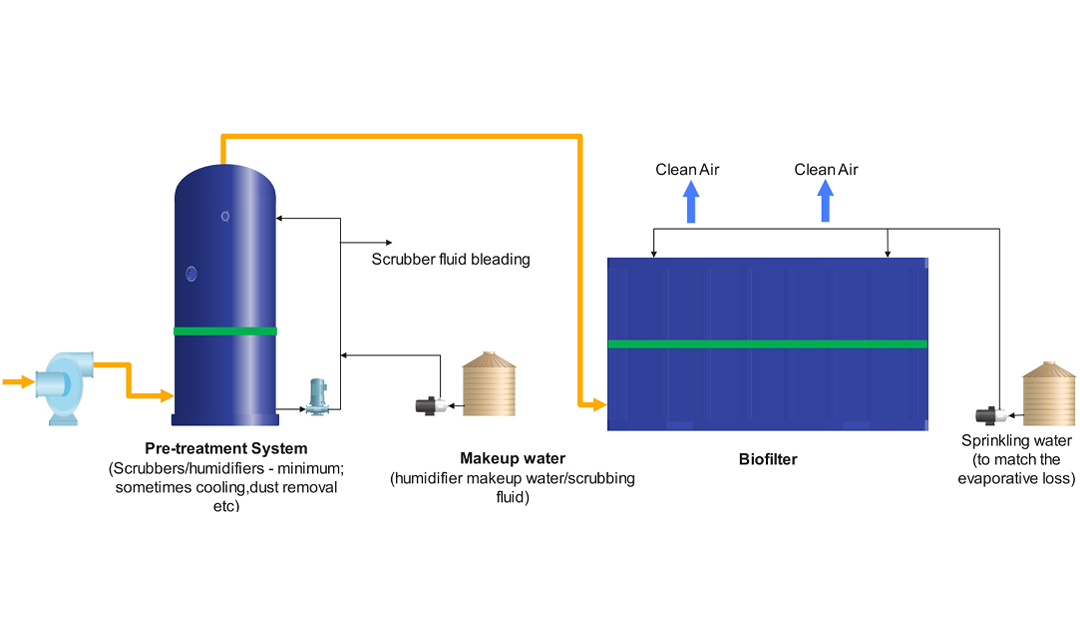
Schematic representation of biofilter
Bioscrubber
Bioscrubber is an odour treatment method said to be a combination of a gas scrubber and a biological reactor. In this process physical separation or absorption of odors in the liquid phase occurs in the gas scrubber and the biological treatment occurs in the bioreactor. The liquid leaving the bioreactor (effluent) is recirculated to the top of the column. This facilitates efficient gas cleaning of highly soluble pollutants.
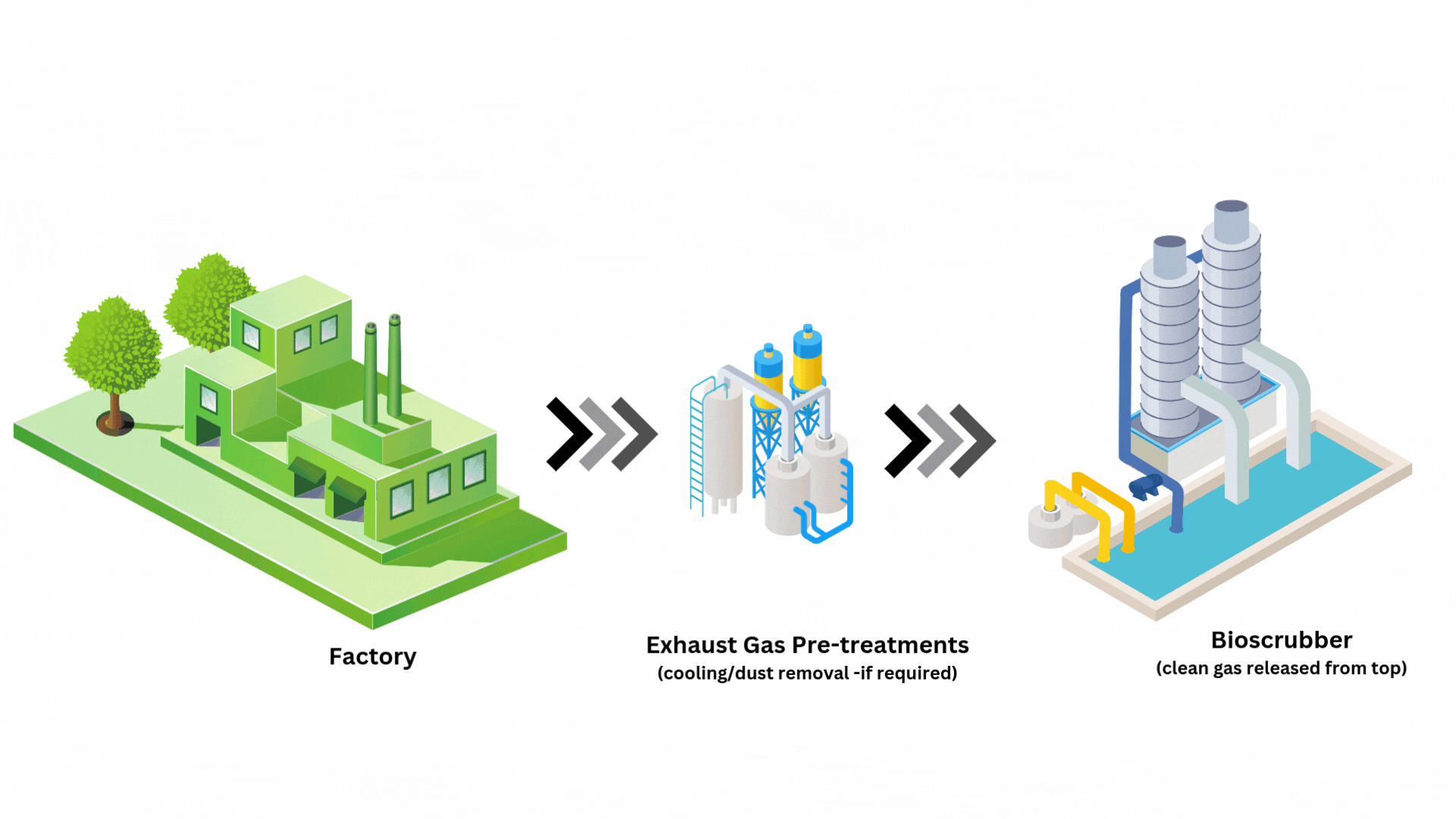
Pollutants in the air stream are removed through the bioscrubbers in the following ways: adsorption, absorption, condensation and biodegradation. It is generally preferred to use packed tower absorbers for bioscrubbers as others (wet cyclone, spray tower and venturi scrubber) show poor elimination efficiency for compounds with poor solubility in water. Generally, resistance to corrosion caused by gases and liquids, resistance to UV and thermal and mechanical resistance against temperatures are all considered while designing an absorption tower. The pollutant absorbed liquor from the scrubber undergoes continuous aeration in the bioreactor, and the active microbial culture converts the pollutant into CO2, H2O, and biomass.
The “lean” water, or bioreactor effluent, is cycled back to the absorber and used again. Bioreactors for bioscrubbing work on similar principles to activated sludge tanks used in wastewater treatment systems in terms of both design and operation. The primary distinction is that with bioscrubbing, the hydraulic retention period is typically significantly longer and equal to the sludge retention time. For this reason, bioscrubbers do not need sludge retention/separation facilities. The majority of bioscrubbers on the market today are made to remove just one type of pollutant. To give additional efficient odour management, increased operating flexibility, and other advancements in traditional designs of bioscrubbers have been examined, including the sorptive-slurry bioscrubber and the anoxic bioscrubber, airlift bioscrubber, spray column bioscrubber, two-liquid phase bioscrubber, or two-stage bioscrubber
A counter current packed tower is considered over a co-current or cross-flow towers owing to its lower pressure drop, lower energy costs and higher absorption efficiency. The ability of the bioscrubber to produce and sustain significantly larger volumes of microbial biomass in fewer process units, while retaining very high specific substrate utilization rates, is a considerable advantage over a typical biofilter and biotrickling filter. The bioreactor can be started by inoculation with activated sludge from a wastewater treatment facility and by microbial development. It relies on environmental factors like temperature, ionic strength, pH, and the presence of hazardous substances and substrate concentration. Bioscrubbers are generally used to remove ammonia, odours from wastewater treatment plants and hydrogen sulfide. The bioscrubber system is particularly advantageous when there is a good wastewater treatment plant available, thereby the load from the bioscrubber can be handled in the wastewater treatment plant and also the additional inventories such as blowers and tanks can be avoided.
 Schematic diagram of bioscrubber
Schematic diagram of bioscrubber
Biotrickling filters
This is a recent technology using more sophisticated biological waste gas treatment equipment. Like biofilters, it uses microorganisms fixed on a media and aqueous solution containing essential nutrients is trickled over the filter bed. The microorganisms grow as a biofilm and as the solution reaches the biofilm, it degrades it. The filter beds are usually made of an inert material (natural or synthetic) such as open pore synthetic foam, dump plastic packing and structure plastic packing. Other materials that have been used are TDRP (Tire-derived rubber particle), glass, ceramics and lava rock. Like biofiltration this method is simple and of low cost and is quite effective removing up to 90% of volatile organic compounds (VOCs). It is also effective for removing nitrogen components, chlorine laden components and sulphur compounds. But require sophisticated control system and continuous monitoring and makeup of nutrients to ensure the adequacy of the treatment.
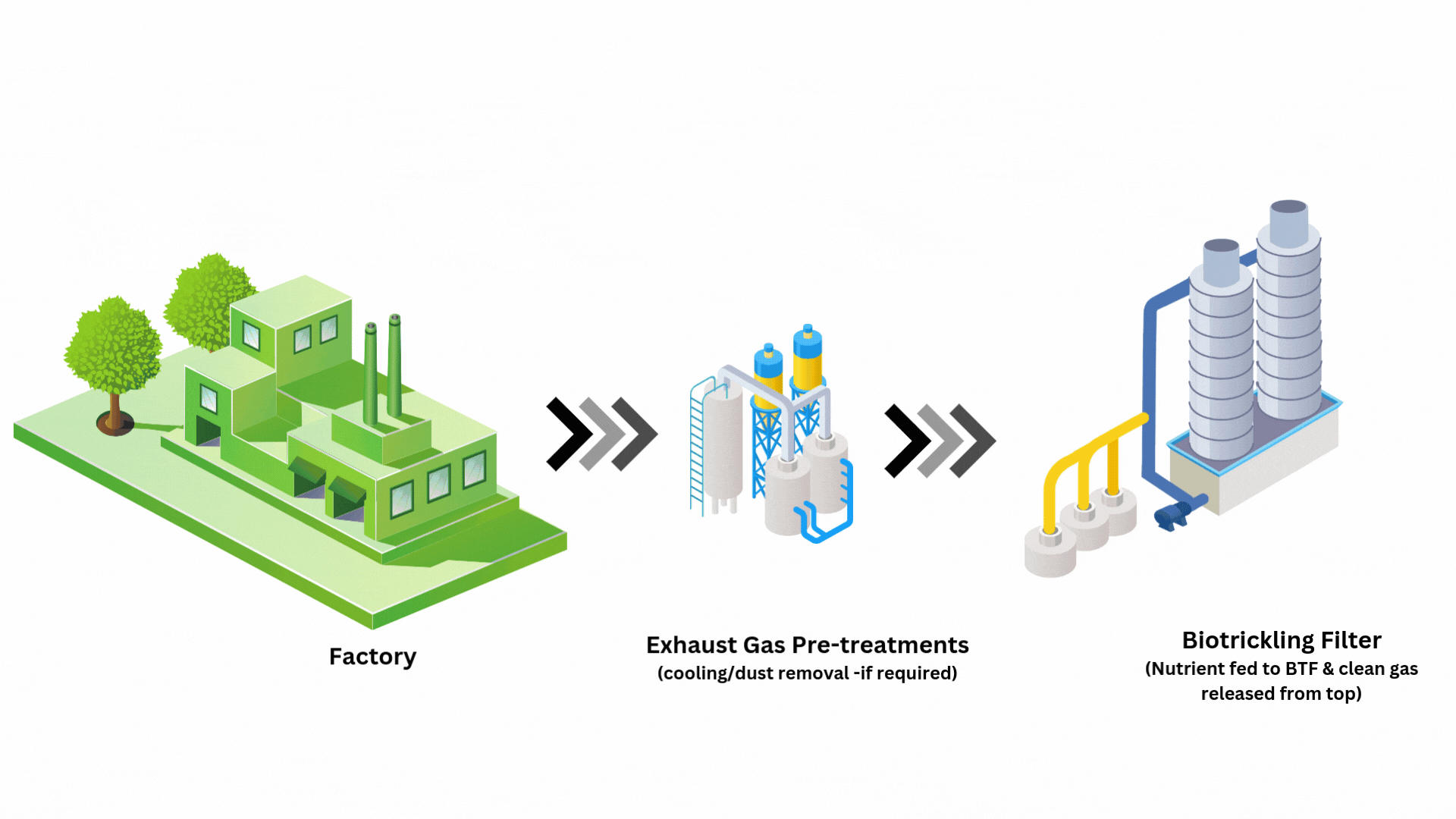
Biotrickling filters are a combination of biofilters and bioscrubbers in which bacteria are immobilized on a carrier or filter material. The filter bed must be always covered with water meaning water must be uniformly sprayed. The contaminants are absorbed and decomposed by the biofilm. The circulating liquid must be checked for its nutrients (serve as feed for biofilm), pH and salt concentration. Here gas which is irrigated with an aqueous solution containing essential nutrients is carried through the filter bed. The flow of gas can be in the co-current or counter-current mechanism. Some studies suggest that co-current is better. Most of the contaminants are degraded by the biofilm. The extent of action by the filter bed depends on the activity of the microorganisms present. The filter bed will be home to a large cluster of microorganisms- aerobic and anoxic. The primary degraders constitute only a small fraction and a much larger fraction is occupied by the secondary degraders like bacteria, yeasts, fungi, and protozoa. The secondary degraders play a noteworthy role in reducing rate of biomass accumulation and recycling inorganic nutrients. Biotrickling filters are operated in temperature range of 10-40 ℃ which is the best temperature for the growth of mesophilic organisms. They are generally used to remove contaminants like hydrogen sulphide, ammonia and methanethiol.

Schematic diagram of biotrickling filter
Conclusion
Industrial odours are a major problem. The primary cause of industrial odour pollution is the airborne presence of volatile chemicals that are transported with the wind. Odorous compounds are typically volatile, corrosive and irritating, even at very low concentrations, and cause odour nuisance due to their low odour thresholds. Measurement of odour is very important and this is done by various methods like Indicator tubes, Dynamic olfactometry, Gas chromatography and electronic noses. Numerous physical-chemical and biological odour control systems have been documented in the literature to reduce the annoyance of odours emanating from the industries. The advantages of biological procedures over other methods are their efficacy, affordability, chemical-free operation, and environmental friendliness. Biological methods include use of biofilters, bioscrubbers and biotrickling filters. The biological methods are being further developed promising a remarkable future for controlling industrial odours.




